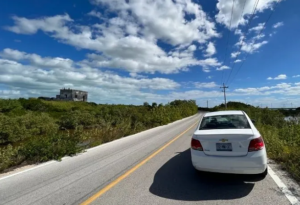What kind of insurance do I need to drive in New Mexico?

Who is covered by your auto insurance policy?
In New Mexico, auto insurance policies typically provide coverage for the following individuals:
- Named Insured:
- The primary policyholder, often the owner of the vehicle, is the named insured. This person is the one who purchased the insurance policy.
- Resident Relatives:
- Immediate family members living in the same household as the named insured are usually covered. This can include spouses, children, and other relatives.
- Permissive Users:
- Individuals who have the owner’s permission to use the insured vehicle are generally covered. This can include friends, family members, or others given explicit permission to drive the insured vehicle.
It’s crucial to remember that different insurance policies may have different coverage, and some may have particular restrictions or limits. Furthermore, insurance usually follows the car and not the driver. This implies that your insurance will usually cover the majority of the damages in an accident involving someone who has permission to drive your car.
It’s important to thoroughly study the terms and conditions of any vehicle insurance policy you purchase or review in New Jersey to find out who is covered and under what conditions. It’s wise to get clarification from your insurance provider if you have any specific questions about your coverage.
Types of New Mexico’s auto insurance coverage

It is mandatory in every state to possess specific kinds of insurance with minimum liability limits. It is recommended by the insurance industry that you have bodily injury liability limits of at least $300,000 per event and $100,000 per person.
According to New Mexico law, drivers must carry motor liability insurance. Being a traditional tort state, New Mexico requires you to file a lawsuit in order to recover disputed damages for property and injuries if you are in an accident with another vehicle. In other words, your losses are covered by that driver’s insurance carrier. According to New Mexico law, auto insurance policies must include the following:
Liability – Minimum Required:
- $25,000 per person for bodily injury
- $50,000 per accident for bodily injury
- $10,000 per accident for property
Uninsured/underinsured motorist coverage This extra policy is available to insured drivers who are worried about being involved in a collision with an uninsured driver in order to protect their losses.
Medical Payments Coverage or MPC Regardless of who is at fault, this extra coverage covers the reasonable costs you and your passengers incur due to injuries sustained in a car collision. The available coverage amounts differ across companies. If you don’t have health insurance, you might choose to get it to add to your existing coverage.
Collision & Comprehensive Damages to your car brought on by an object, another vehicle, or a rollover are covered by collision insurance. Although it’s not mandated by law, most lenders will not provide financing without collision coverage. Your personal car is protected from risks such as fire, theft, glass breakage, wind, flood, or vandalism by comprehensive insurance. Moreover, comprehensiveness is not necessary. To save money on insurance premiums, think about removing these kinds of coverage if your automobile is older.
Carrying more insurance than the bare minimum required by law is advised if you can afford it. Consider how much insurance you’ll require in the most critical situations. Families should consult with a company representative or insurance provider to ascertain the appropriate amount for each member of the family.
What’s New Mexico’s car insurance cost?

Age-specific average prices for vehicle insurance in New Mexico
It is a normal occurrence for your auto insurance rates to increase with age. Younger drivers typically pay more for auto insurance because insurance companies view them as higher-risk drivers. In New Mexico, a 16-year-old driver’s auto insurance costs $6,861, while a 50-year-old driver’s insurance only costs $1,188 annually.
New Mexico car insurance prices by age
| Age | Average Yearly Rate |
| 16 | $6,860.97 |
| 17 | $6,028.38 |
| 18 | $5,092.75 |
| 19 | $3,144.14 |
| 20s | $1,726.11 |
| 30s | $1,294.07 |
| 40s | $1,262.35 |
| 50s | $1,188.40 |
| 60s | $1,222.05 |
| 70s | $1,577.96 |
New Mexico is the 19th most costly state in which to get auto insurance for a 16-year-old driver if you are shopping for insurance for a young driver.
Gender-specific average prices for auto insurance in New Mexico
Underwriters utilize gender as a rating component even though it has less of an effect on vehicle insurance premiums than age or state.
| Gender | Average Yearly Rate |
| Male | $1,317.66 |
| Female | $1,313.96 |
Comparing quotes from other insurance providers is the best course of action if you believe your current auto insurance provider isn’t giving you the best value for your money.
New Mexico auto insurance costs broken down by marital status
Aside from the presents given during the wedding, one advantage of marriage is usually a reduction in the cost of motor insurance. Married drivers in New Mexico save $108 on auto insurance annually. This exceeds the average savings of $76 across the United States.
| Marital Status | Average Annual Premium |
| Single | $1,317.66 |
| Married | $1,209.50 |
| Divorced | $1,317.66 |
| Widowed | $1,300.35 |
New Mexico’s average auto insurance costs broken down by credit score
Auto insurance providers forecast a customer’s level of dependability based on their credit history. According to historical research, drivers with good credit tend to be more dependable auto insurance customers because they make claims less frequently.
In comparison to a driver with a poor credit history, an exceptional credit driver in New Mexico saves $1,047 in insurance payments annually. Find out more about how credit may affect the price of auto insurance in New Mexico.
| Credit Level | Average Annual Rate |
| Very Poor (300-579) | $2,196.43 |
| Fair (580-669) | $1,867.06 |
| Good (670-739) | $1,582.06 |
| Very Good (740-799) | $1,363.55 |
| Exceptional (800-850) | $1,148.93 |
New Mexico’s average premium for high-risk drivers’ auto insurance
Your auto insurance premiums will inevitably go up if you are convicted of a traffic infraction or are judged to be at fault in an accident. Your auto insurance policy will cost more the more infractions you accrue. Your first minor at-fault crash in New Mexico will result in an annual premium of $641 for your auto insurance. One of the most serious traffic infractions, a DUI or DWI, can raise your annual insurance costs in New Mexico by as much as $686.
| Age | Average Annual Premium |
| DUI/DWI | $2,017.26 |
| Reckless Driving | $2,166.99 |
| At-Fault Accident (<$1,000) | $1,972.34 |
| At-Fault Accident ($1,000-$2,000) | $2,524.73 |
| At-Fault Accident (>$2,000) | $1,972.34 |
| Open Container | $2,088.54 |
| Speeding (21-25 MPH > limit) | $2,229.85 |
| Speeding (16-20 MPH > limit) | $2,229.85 |
If you are looking for a better deal on auto insurance, it’s worth comparing rates to get reasonably priced coverage that suits you.
New Mexico’s average car insurance costs broken down by coverage
The level of coverage you choose will determine the monthly cost of your auto insurance. Low-deductible comprehensive coverage is usually more expensive than liability-only coverage. The difference in cost in New Mexico between the $500 deductible comprehensive coverage and the state-minimum liability-only coverage is $689.
| Coverage Level | Average Annual Rate |
| $100K/$300K/$100K Bodily Injury/Property Damage — Liability Only | $672 |
| $100K/$300K/$100K Bodily Injury/Property Damage: $1,000 Comprehensive/Collision | $1,218 |
| $100K/$300K/$100K Bodily Injury/Property Damage: $500 Comprehensive/Collision | $1,362 |
| $50K/$100K/$50K Bodily Injury/Property Damage — Liability Only | $577 |
| $50K/$100K/$50K Bodily Injury/Property Damage: $1,000 Comprehensive/Collision | $1,122 |
| $50K/$100K/$50K Bodily Injury/Property Damage: $500 Comprehensive/Collision | $1,266 |
| State Minimum — Liability Only | $488 |
| State Minimum: $1,000 Comprehensive/Collision | $1,032 |
| State Minimum: $500 Comprehensive/Collision | $1,177 |
Ways to Reduce Auto Insurance Costs in New Mexico

- Compare Quotes: Obtain quotes from multiple insurance providers. Each company uses its own formula to determine rates, so prices can vary significantly.
- Bundle Policies: Consider bundling your auto insurance with other policies, such as homeowners or renters insurance, to potentially qualify for a discount.
- Increased Deductibles: A higher deductible usually leads to lower premiums. Just be sure you can comfortably afford the deductible in case of a claim.
- Maintain a Good Driving Record: Safe driving can contribute to lower premiums. Avoid accidents and traffic violations to keep your rates down.
- Ask About Discounts: Inquire about discounts for safe driving, good grades (if applicable), and other factors that may apply to you.
- Drive a Safe and Affordable Car: The type of car you drive can impact insurance costs. Generally, safer and less expensive cars have lower insurance premiums.
- Consider Your Coverage Needs: While looking for affordability, ensure that the coverage meets your needs. Full coverage typically includes liability, comprehensive, and collision coverage.
Don’t forget to customize your insurance to meet your unique needs and circumstances. Reviewing your policy on a regular basis and comparing quotes will help you make sure you’re getting the greatest value.
Auto insurance claim process
Report the Incident: The first thing you should do after an accident or damage is to notify your insurance provider. Usually, you can accomplish this by calling the insurer’s claims hotline, utilizing a mobile app, or going online. Give specifics like the incident’s description, date, time, and location.
Information Exchange: Share details with the people involved, such as names, contact information, insurance information, and car data. Get the details of any witnesses, if there are any. Document the scene with photos, if possible, to provide visual evidence.
File a Police Report: It is wise to make a police report in certain situations, particularly if there are injuries or substantial damage. When processing the insurance claim and assigning blame, this document may be very important.
Claim Adjuster Assessment: The insurance company assigns a claims adjuster to your case. The adjuster will investigate the incident, review the police report, inspect the damages, and assess the costs involved. They may also interview involved parties and witnesses.
Estimate and Repair: The insurance company evaluates the adjuster’s findings to determine whether to declare the car a total loss or to issue an estimate for repairs. The repairs will start if the estimate is approved. While some insurers let you select the repair shop, others have preferred shops.
Medical Claims: In the event that injuries occur, the medical claims procedure starts. This entails providing the insurance company with medical bills, records, and other pertinent paperwork. The kind of insurance and state laws will determine what is and is not covered for medical costs.
Resolution and Payment: The insurance provider will make a payout after the evaluation and repair procedures are finished. This can entail paying for repairs, paying for a totaled car, or paying for medical bills. The resolution process may take several weeks.
Appeals Process: If you disagree with the insurance company’s decision, there’s usually an appeals process. This may involve providing additional documentation or appealing to a higher authority within the insurance company.
The procedure for filing a car insurance claim is intended to assist people in getting over mishaps or unforeseen circumstances. Throughout the whole claims process, it is imperative that you adhere to the procedure exactly, give accurate information, and communicate with your insurance carrier in a clear and concise manner.
Some advice for accelerating your auto insurance claim
Here are some pointers to speed up the process of filing a claim on your auto insurance.
Download the mobile app for your insurance: Through their applications, a lot of auto insurance companies let drivers submit claims. While each company’s app may have different features and usability, many allow you to attach files such as written statements, images, and supporting evidence to support your claim. Certain applications facilitate the tracking of your claim’s progress.
Compile the required data prior to submitting the claim: When making a car insurance claim, the more organized you are, the faster you will find the information you need. Delays may result from omitting important information, missing uploading accident images, or not mentioning the other driver’s insurance.
Remember when things are due: The type of auto insurance claim, the insurer, and the location all affect the filing deadlines. As soon as you can after an accident, get in touch with your motor insurance provider to find out if there are any deadlines for submitting paperwork and submitting a claim. To ensure that you don’t forget the deadline, add these to your paper or digital calendar and, if at all possible, attach an alert.
Contact your auto insurance provider again. The severity of the collision, whether more than one motorist was involved, and the amount of time it takes the adjuster to go through all the paperwork can all affect how quickly a claim is settled. It’s easier to make sure everything is on track for settlement if you follow up with your insurance.
Common Myths and Misconceptions About Car Insurance
A lot of myths and misconceptions surround the subject of auto insurance. These false beliefs have the potential to cause confusion and, occasionally, to cause people to make poor decisions for themselves. Let’s dispel some of these widespread rumors and clear up any misunderstandings regarding auto insurance.
1. Myth: Red cars cost more to insure: The idea that red automobiles cost extra to insure is one that is frequently spread. The truth is that your car’s color has no bearing on your insurance costs. A driver’s history and vehicle make, model, and year are of greater interest to insurers.
2. Myth: Minimum Coverage is Always Sufficient: Some people think it’s always sufficient to choose the bare minimum of coverage. However, in the event of a serious accident, basic coverage might not provide you with enough protection. In order to improve your financial security, it’s critical to evaluate your unique demands and take into account supplemental coverage.
3. Myth: Your Insurance Covers Everything: Although insurance offers necessary protection, it does not cover every eventuality. It’s important to know the restrictions of your policy. Generally speaking, things like normal wear and tear, mechanical malfunctions, or deliberate destruction are not covered.
4. Myth: Personal Auto Insurance Covers Business Use: A personal auto insurance coverage may not protect you if you use your car for work-related travels. Commercial auto insurance is frequently necessary for business use in order to guarantee adequate coverage in the event of work-related accidents.
5. Myth: Older Drivers Always Pay More: Many insurance companies give senior citizens discounts, despite the common misconception that older drivers always pay higher prices. Older drivers can frequently receive reduced rates due to their experience and safe driving records.
Clarifying Misconceptions:
1. Misconception: Speeding Tickets Don’t Affect Rates Significantly: Some people believe that a single speeding ticket won’t have a big effect on insurance costs. In actuality, fines for speeding can result in higher insurance rates, and more expensive rates may follow subsequent infractions. To keep insurance costs low, driving safely must be your top priority.
2. Misconception: Credit Score Doesn’t Affect Auto Insurance: It is true that your credit score affects how much your auto insurance costs. Credit history is a common tool used by insurers to evaluate a policyholder’s dependability. Better credit makes one more trustworthy and might result in lower insurance costs.
3. Misconception: Comprehensive Coverage Covers Everything: Even though comprehensive coverage is broad, it doesn’t address every eventuality that could arise. It is essential to comprehend the precise contents and exclusions of your policy. For instance, it usually doesn’t cover routine upkeep or mechanical failures.
It’s critical to bust these myths and clear up misunderstandings in order to make knowledgeable judgments about auto insurance. Policyholders can ensure they have the appropriate protection for their needs and can navigate the market more skillfully by being aware of the reality of insurance coverage.
I believe if you can observe my entire blog, you may get a valid idea of car insurance coverage in New Mexico. Types of New Mexico’s auto insurance coverage, New Mexico’s car insurance cost, Auto insurance claim process and ways to reduce auto insurance costs in New Mexico.
